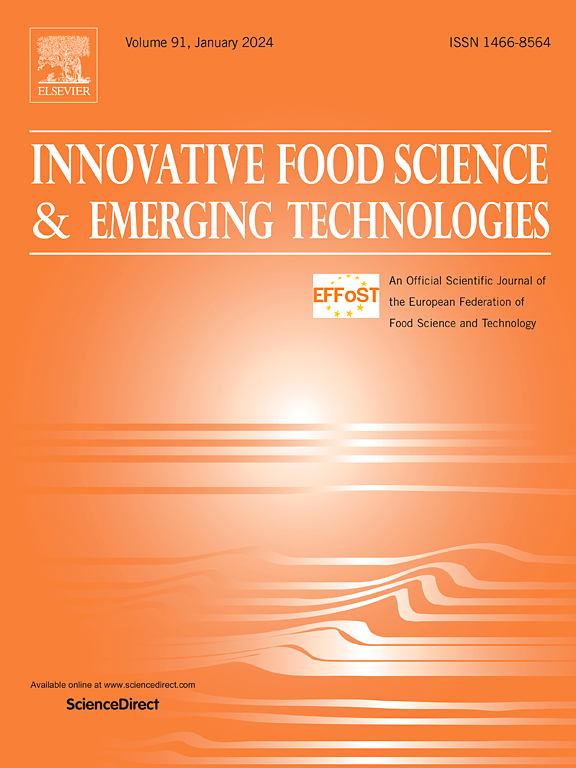Saltiness perception enhancement of myofibrillar protein gel via microwave treatment: Microwave promotes protein aggregation
IF 6.3
1区 农林科学
Q1 FOOD SCIENCE & TECHNOLOGY
Innovative Food Science & Emerging Technologies
Pub Date : 2024-12-27
DOI:10.1016/j.ifset.2024.103912
引用次数: 0
Abstract
This study aims to elucidate the mechanism by which microwave treatment enhances saltiness perception by altering the microstructure of myofibrillar protein gels, focusing on changes in gel microstructure, protein aggregation behavior, and molecular conformation. Myofibrillar protein gels with low ionic strength (0.2 mol/L) were prepared by intermittent microwave heating at 300, 500, 800, and 1000 W (water bath heating as control). On the condition that there are no significant differences in the cooking loss and sodium ion retention across the various treatments, protein gels heated at high power (800 and 1000 W) were perceived as saltier and formed more uniform and denser microstructures. Since the high power microwave exhibited the faster heating and aggregation rates, myofibrillar proteins became more prone to aggregation, forming aggregates that were more difficult to solubilize, with larger particle sizes and lower zeta potentials. Molecular conformation analysis revealed that the protein treated by microwave heating exhibited increased β-sheet formation, weaker hydrophobic interaction, but higher levels of disulfide bonds, thus facilitating the cross-linking of protein gels. Briefly, high-power microwaves changed protein conformation, promoting aggregation and resulting in the formation of a dense and uniform microstructure. This structural transformation shortened the diffusion pathways of sodium ions, significantly enhancing saltiness perception.
Industry relevance: Meat products on the market typically contain high levels of salt. Microwave heating has the potential to create a dense microstructure in meat products, thereby enhancing saltiness perception. This study provides a scientific basis for applying microwave heating in salt reduction within the meat industry.
微波处理增强肌原纤维蛋白凝胶的咸味感知:微波促进蛋白质聚集
本研究旨在阐明微波处理通过改变肌原纤维蛋白凝胶的微观结构来增强盐感的机制,重点研究了凝胶微观结构、蛋白质聚集行为和分子构象的变化。采用300、500、800、1000 W间歇微波加热(水浴加热为对照)法制备低离子强度(0.2 mol/L)的肌原纤维蛋白凝胶。在不同处理的蒸煮损失和钠离子保留没有显著差异的情况下,高功率(800和1000 W)加热的蛋白质凝胶被认为更咸,形成更均匀和致密的微观结构。由于高功率微波的加热和聚集速度更快,肌原纤维蛋白更容易聚集,形成更难溶解的聚集体,颗粒尺寸更大,zeta电位更低。分子构象分析表明,微波加热后的蛋白质β-薄片形成增加,疏水相互作用减弱,但二硫键水平较高,有利于蛋白质凝胶的交联。简而言之,高功率微波改变了蛋白质的构象,促进了聚集,形成了致密而均匀的微观结构。这种结构转变缩短了钠离子的扩散路径,显著增强了盐感。行业相关性:市场上的肉类产品通常含有高水平的盐。微波加热有可能在肉制品中产生致密的微观结构,从而增强咸感。本研究为微波加热在肉类工业中应用于减盐提供了科学依据。
本文章由计算机程序翻译,如有差异,请以英文原文为准。
求助全文
约1分钟内获得全文
求助全文
来源期刊
CiteScore
12.00
自引率
6.10%
发文量
259
审稿时长
25 days
期刊介绍:
Innovative Food Science and Emerging Technologies (IFSET) aims to provide the highest quality original contributions and few, mainly upon invitation, reviews on and highly innovative developments in food science and emerging food process technologies. The significance of the results either for the science community or for industrial R&D groups must be specified. Papers submitted must be of highest scientific quality and only those advancing current scientific knowledge and understanding or with technical relevance will be considered.

 求助内容:
求助内容: 应助结果提醒方式:
应助结果提醒方式:


